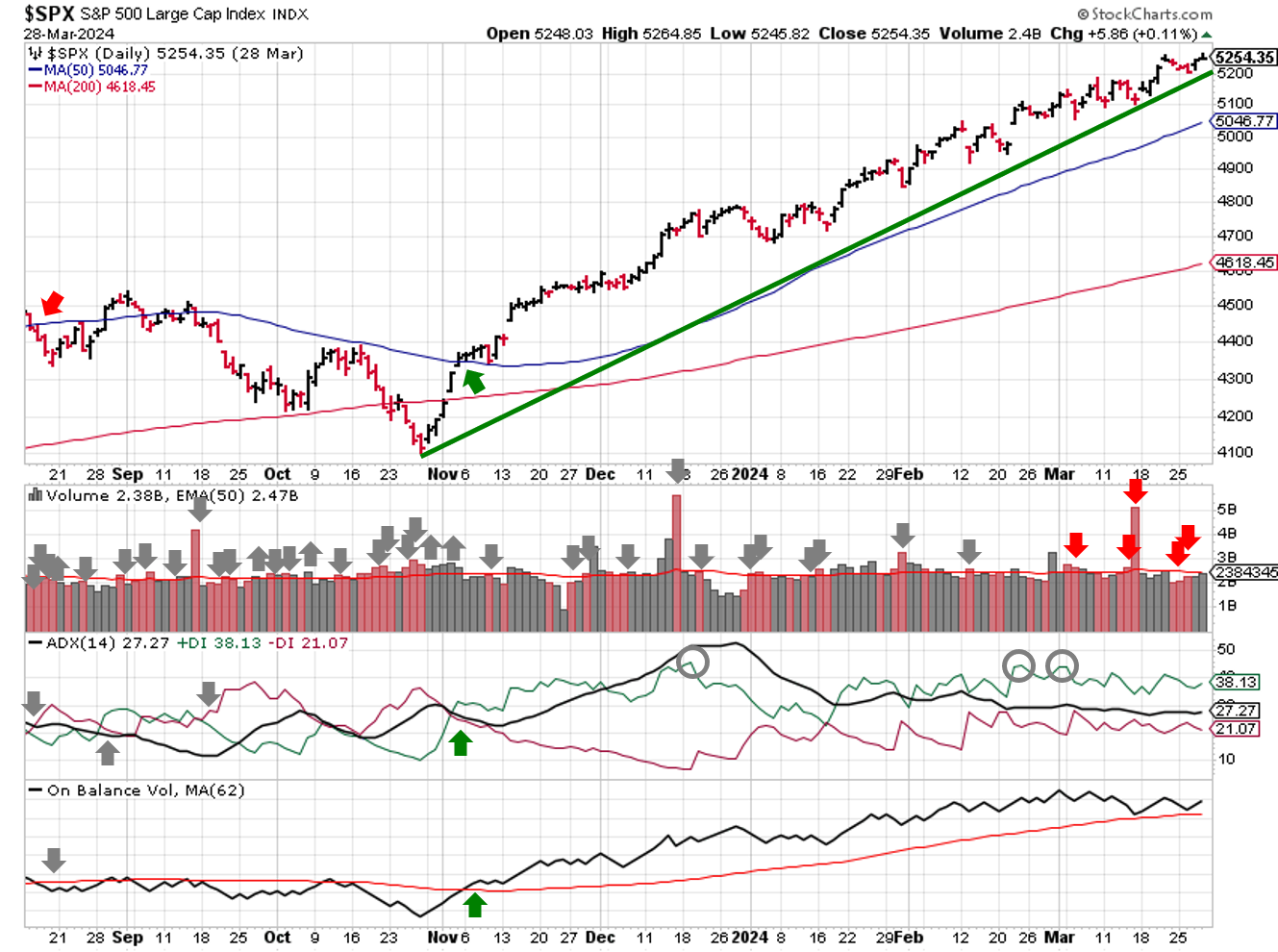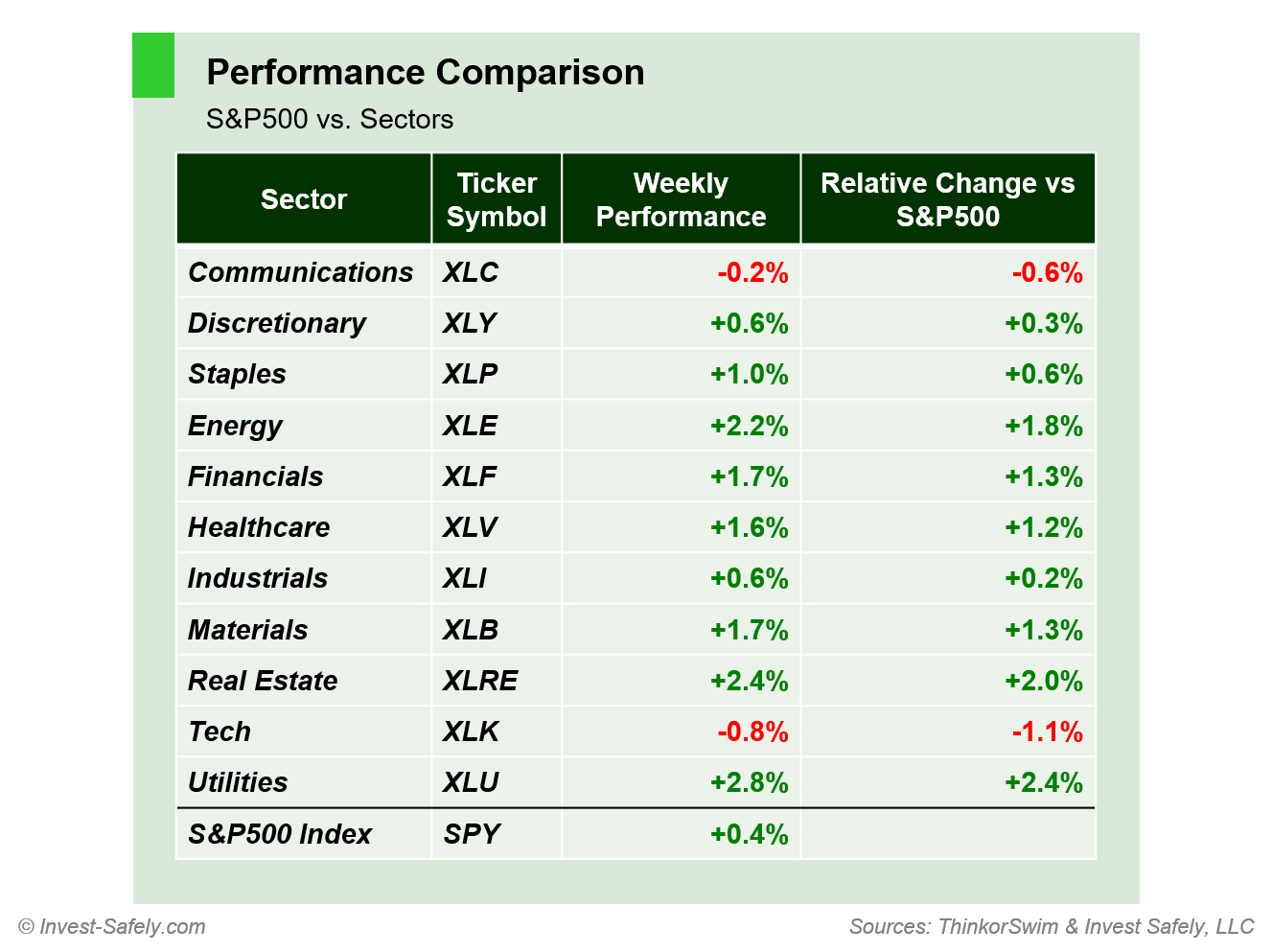Stock Market Outlook
For The Week Of March 31st =
Uptrend
INDICATORS
-
ADX Directional Indicators: Uptrend
Price & Volume Action: Uptrend
On Balance Volume Indicator: Uptrend
The S&P500 ($SPX) rose 0.4% last week, ending Q1 with a gain of 10.8%. The index sits ~4% above the 50-day moving average, and ~14% above the 200-day moving average.
SPX Technical Analysis entering the Week of Mar 31 2024
All three signals show an uptrend in place. Institutional selling picked up last week, although volume remained below average.
In terms of sector performance, Real estate ($XLRE) claimed the top spot last week, after being the worst sector two weeks ago. Energy ($XLE) was a close second. Technology ($XLK) underperformed last week.
S&P Sector Performance for Week 13 of 2024
For the quarter, the $SPY ETF was up 11%, slightly more than the actual index. Communications ($XLC) topped the gainers for the quarter, rising ~13% (+2% vs. the SPY). Capital flows were not kind to Real Estate ($XLRE), which dropped ~1.5% for the quarter. That's a -12.5% loss versus the overall index.
From an asset class perspective, "commodities" were the best in Q1, albeit with a very large range of performance. Bitcoin, livestock, and oil were the best performers, while industrial materials and agriculture lagged.
In second place was U.S. equities (i.e. $SPX), again with some variation by sector as discussed above. Then came gold, bond funds, and finally the US dollar. All in all, this breakdown is typical of a "nominal expansion", or economic growth (+GDP) with rising prices (+inflation).
COMMENTARY
The third and final GDP revision showed the US economy grew 3.4% in Q4 of 2023, slightly higher than the 3.2% reported in the second estimate. Consumer spending was revised higher, which isn't surprising given "sticky" inflation data.
Government spending continues to contribute a large portion of GDP, increasing 4.6% year over year and showing now signs of slowing. This may be on reason that asset prices and economic data behaved like it's a nominal expansion (rising growth and rising inflation), while consumers "felt" that conditions are more recessionary (falling growth and rising inflation).
During the trading holiday on Friday, PCE data was released. Thankfully, there were no surprises as changes were inline with expectations.
| PCE(y/y) | Actual | Prior | Expected |
| Headline | +2.5% | +2.4% | +2.5% |
| Core | +2.8% | +2.9% | +2.8% |
This week is all about jobs, with JOLTS and NFP releases, as well as several speeches by Fed officials (including another one from Powell on Wednesday).
Best to Your Week!
P.S. If you find this research helpful, please tell a friend.
If you don't, tell an enemy.
Sources: Bloomberg, CNBC, Federal Reserve Bank of St. Louis, Hedgeye, U.S. Bureau of Economic Analysis, U.S. Bureau of Labor Statistics
Share this Post on:

How to Make Money in Stocks: A Winning System in Good Times and Bad.
It's one of my favorites.
I regularly share articles and other news of interest on:
Twitter (@investsafely)
Facebook (@InvestSafely)
LinkedIn (@Invest-Safely)
Instagram (@investsafely)
Invest Safely, LLC is an independent investment research and online financial media company. Use of Invest Safely, LLC and any other products available through invest-safely.com is subject to our Terms of Service and Privacy Policy. Not a recommendation to buy or sell any security.
Charts provided courtesy of stockcharts.com.
For historical Elliott Wave commentary and analysis, go to ELLIOTT WAVE lives on by Tony Caldaro. Current counts can be found at: Pretzel Logic, and 12345ABCDEWXYZ
Once a year, I review the market outlook signals as if they were a mechanical trading system, while pointing out issues and making adjustments. The goal is to give you to give you an example of how to analyze and continuously improve your own systems.
- 2015 Performance - Stock Market Outlook
- 2016 Performance - Stock Market Outlook
- 2017 Performance - Stock Market Outlook
- 2018 Performance - Stock Market Outlook
- 2019 Performance - Stock Market Outlook
- 2020 Performance - Stock Market Outlook
IMPORTANT DISCLOSURE INFORMATION
This material is for general communication and is provided for informational and/or educational purposes only. None of the content should be viewed as a suggestion that you take or refrain from taking any action nor as a recommendation for any specific investment product, strategy, or other such purpose. Certain information contained herein has been obtained from third-party sources believed to be reliable, but we cannot guarantee its accuracy or completeness.
To the extent that a reader has any questions regarding the applicability of any specific issue discussed above to his/her individual situation, he/she is encouraged to consult with the professional advisors of his/her choosing. Invest Safely, LLC is not a law firm, certified public accounting firm, or registered investment advisor and no portion of its content should be construed as legal, accounting, or investment advice.
The material is not to be construed as an offer or a recommendation to buy or sell a security nor is it to be construed as investment advice. Additionally, the material accessible through this website does not constitute a representation that the investments described herein are suitable or appropriate for any person.
Hypothetical Presentations:
Any referenced performance is “as calculated” using the referenced funds and has not been independently verified. This presentation does not discuss, directly or indirectly, the amount of the profits or losses, realized or unrealized, by any reader or contributor, from any specific funds or securities.
The author and/or any reader may have experienced materially different performance based upon various factors during the corresponding time periods. To the extent that any portion of the content reflects hypothetical results that were achieved by means of the retroactive application of a back-tested model, such results have inherent limitations, including:
Model results do not reflect the results of actual trading using assets, but were achieved by means of the retroactive application of the referenced models, certain aspects of which may have been designed with the benefit of hindsight
Back-tested performance may not reflect the impact that any material market or economic factors might have had on the use of a trading model if the model had been used during the period to actually manage assets
Actual investment results during the corresponding time periods may have been materially different from those portrayed in the model
Past performance may not be indicative of future results. Therefore, no one should assume that future performance will be profitable, or equal to any corresponding historical index.
The S&P 500 Composite Total Return Index (the "S&P") is a market capitalization-weighted index of 500 widely held stocks often used as a proxy for the stock market. Standard & Poor's chooses the member companies for the S&P based on market size, liquidity, and industry group representation. Included are the common stocks of industrial, financial, utility, and transportation companies. The S&P is not an index into which an investor can directly invest. The historical S&P performance results (and those of all other indices) are provided exclusively for comparison purposes only, so as to provide general comparative information to assist an individual in determining whether the performance of a specific portfolio or model meets, or continues to meet investment objective(s). The model and indices performance results do not reflect the impact of taxes.
Investing involves risk (even the “safe” kind)! Past performance does not guarantee or indicate future results. Different types of investments involve varying degrees of underlying risk. Therefore, do not assume that future performance of any specific investment or investment strategy be suitable for your portfolio or individual situation, will be profitable, equal any historical performance level(s), or prove successful (including the investments and/or investment strategies describe on this site).




